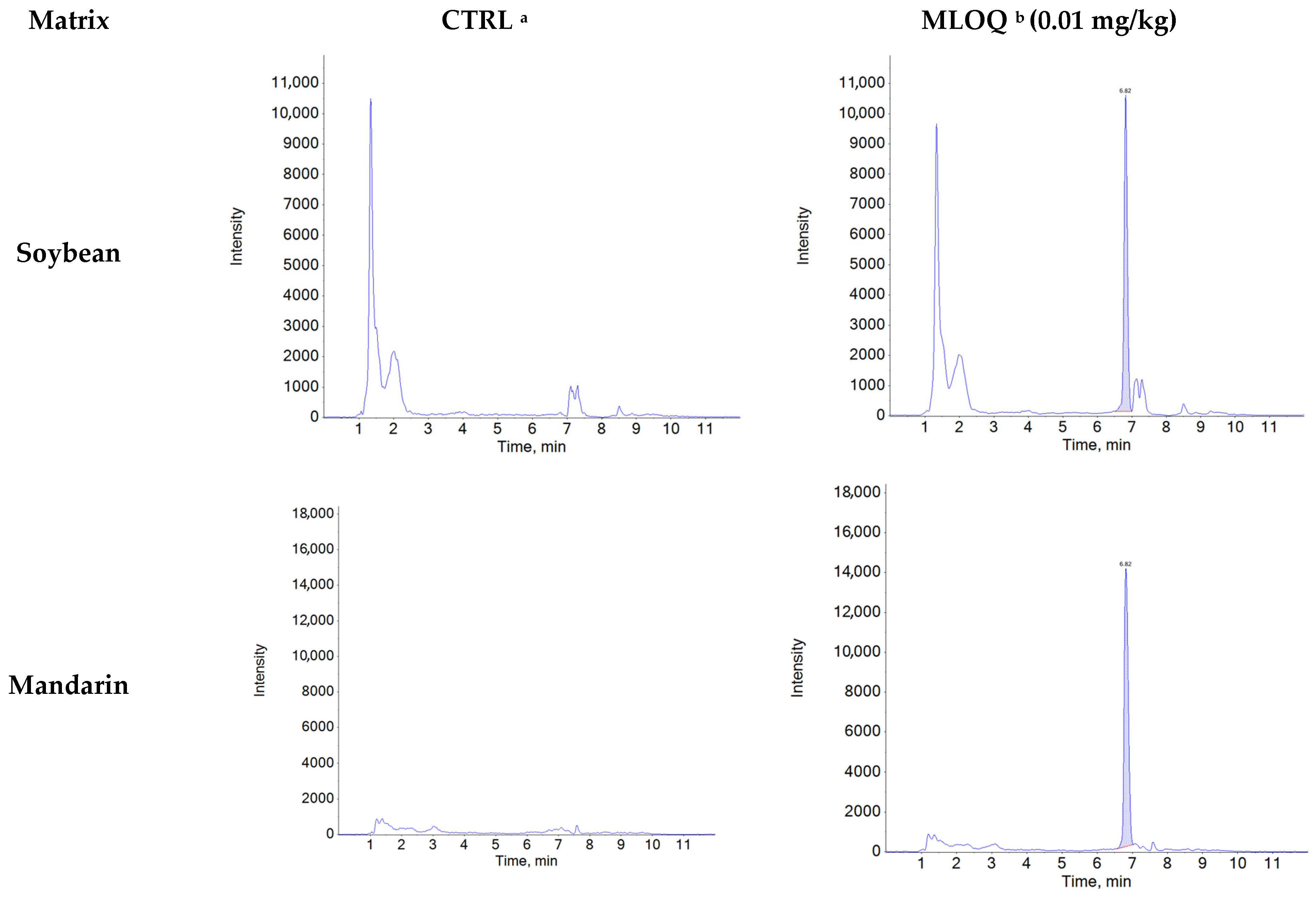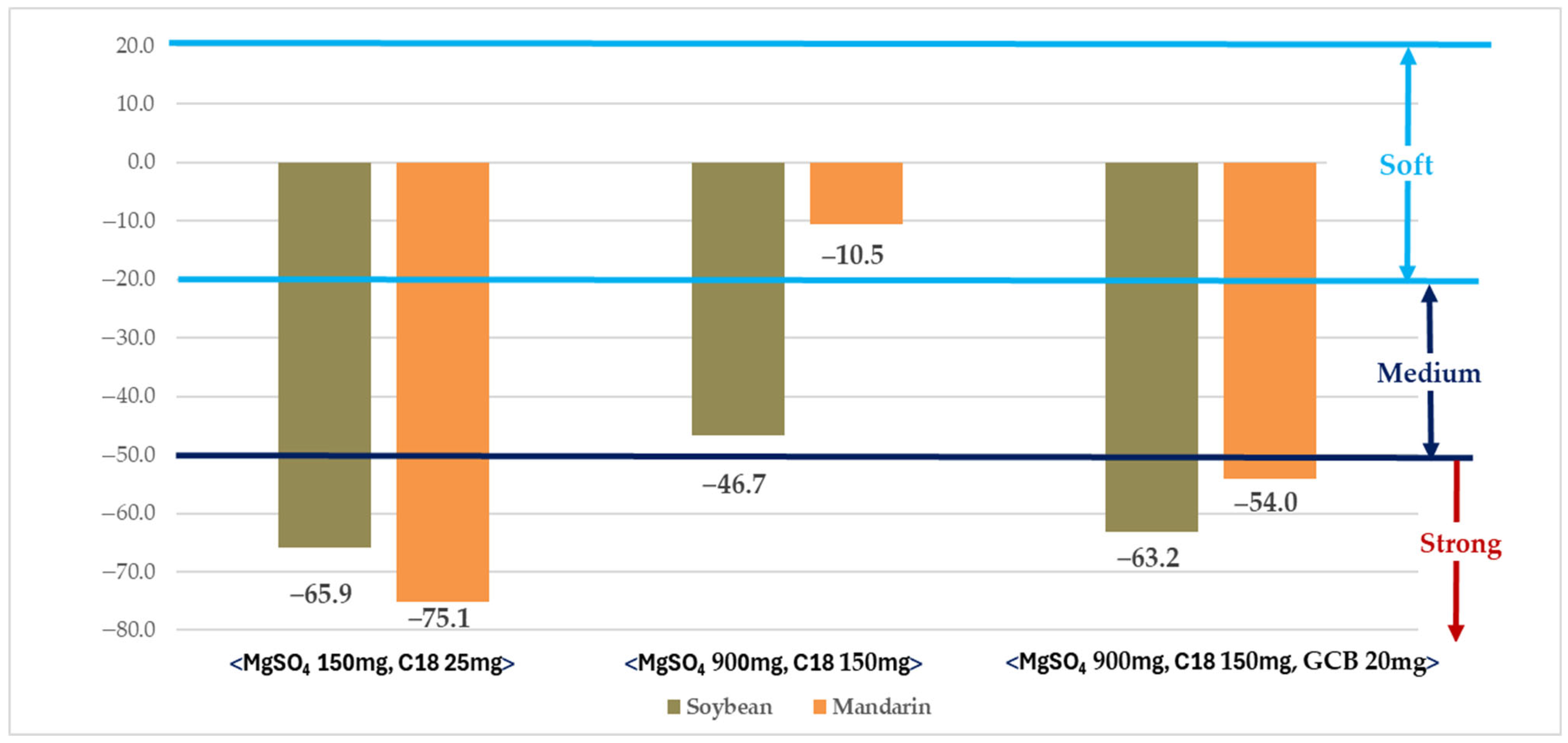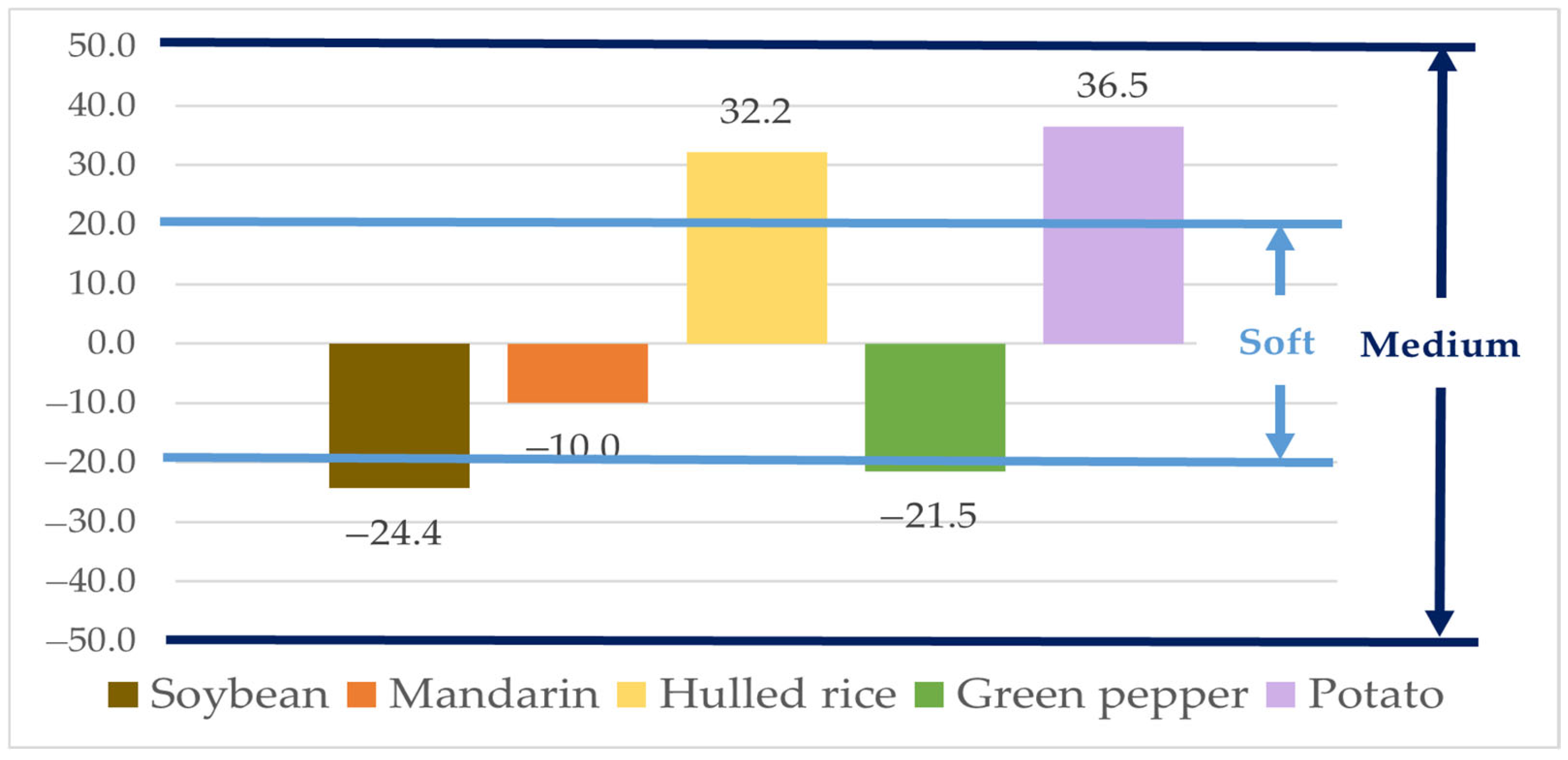Development and Validation of a QuEChERS-Based LC–MS/MS Method for Natamycin in Imported Agricultural Commodities in Korea
Abstract
1. Introduction
2. Materials and Methods
2.1. Chemicals and Reagents
2.2. LC-MS/MS Instrumental Conditions
2.3. Selection and Preparation of Samples
2.4. Optimization and Validation of Extraction and Purification Conditions
2.5. Applicability of the Established Analytical Method
3. Results and Discussion
3.1. Optimization of Extraction and Purification Conditions
3.1.1. Optimization of Extraction Conditions
3.1.2. Optimization of Purification Conditions
3.2. Method Validation
3.2.1. Specificity and Linearity
3.2.2. Method Limit of Quantitation (MLOQ)
3.2.3. Accuracy and Precision
3.2.4. Matrix Effect
3.3. Monitoring of Imported Agricultural Products
4. Conclusions
Author Contributions
Funding
Institutional Review Board Statement
Informed Consent Statement
Data Availability Statement
Acknowledgments
Conflicts of Interest
Appendix A
| Structure |  |
| IUPAC name | (8E,14E,16E,18E,20E)-(1R,3S,5R,7R,12R,22R,24S,25R,26S)-22-(3-amino-3,6-dideoxy-β-D-mannopyranosyloxy)-1,3,26-trihydroxy-12-methyl-10-oxo-6,11,28-trioxatricyclo[22.3.1.05,7]octacosa-8,14,16,18,20-pentaene-25-carboxylic acid |
| Molecular formula | C33H47NO13 |
| Molecular weight (g/mol) | 665.7 |
| Log Kow | −3.67 |
| Log P | −1.1 |
| pKa | 3.58 (strongest acidic) 9.11 (strongest basic) |
| Water solubility (g/L, 20–25 °C) | 0.04 |
| Exact Mass (g/mol) | Precursor Ion (m/z) | Product Ion (m/z) | CV (V) a | CE b | RT c (min) |
|---|---|---|---|---|---|
| 665.3 | 666.2 | 503.0 d | 24 | 17 | 6.8 |
| 485.0 e | 15 | 20 |
| Agricultural Matrix | Linear Equation | R2 |
|---|---|---|
| Soybean | y = 2,720,216.3832x + 7403.6597 | 0.9985 |
| Mandarin | y = 4,564,924.8555x + 17,922.3719 | 0.9954 |
| Hulled Rice | y = 7,831,874.1206x − 4558.4131 | 0.9979 |
| Green Pepper | y = 5,781,466.9529x + 12,118.6316 | 0.9936 |
| Potato | y = 7,565,558.2164x − 2894.3815 | 0.9926 |
Appendix B


References
- Haack, S.E.; Ivors, K.L.; Holmes, G.J.; Förster, H.; Adaskaveg, J.E. Natamycin, a New Biofungicide for Managing Crown Rot of Strawberry Caused by QoI-Resistant Colletotrichum acutatum. Plant Dis. 2018, 102, 1687–1695. [Google Scholar] [CrossRef] [PubMed]
- Meena, M.; Prajapati, P.; Ravichandran, C.; Sehrawat, R. Natamycin: A natural preservative for food applications-a review. Food Sci. Biotechnol. 2021, 30, 1481–1496. [Google Scholar] [CrossRef] [PubMed]
- Welscher, Y.M.t.; Jones, L.; van Leeuwen, M.R.; Dijksterhuis, J.; de Kruijff, B.; Eitzen, G.; Breukink, E. Natamycin Inhibits Vacuole Fusion at the Priming Phase via a Specific Interaction with Ergosterol. Antimicrob. Agents Chemother. 2010, 54, 2618–2625. [Google Scholar] [CrossRef] [PubMed]
- Welscher, Y.M.t.; Napel, H.H.t.; Balagué, M.M.; Souza, C.M.; Riezman, H.; de Kruijff, B.; Breukink, E. Natamycin Blocks Fungal Growth by Binding Specifically to Ergosterol without Permeabilizing the Membrane. J. Biol. Chem. 2008, 283, 6393–6401. [Google Scholar] [CrossRef]
- Eissa, S.; Abdou, A.M.; Mohamed, H. The role of natamycin fortification to extend shelf life of plain yoghurt. Benha Vet. Med. J. 2014, 27, 140–149. [Google Scholar]
- Dalhoff, A.A.H.; Levy, S.B. Does use of the polyene natamycin as a food preservative jeopardise the clinical efficacy of amphotericin B? A word of concern. Int. J. Antimicrob. Agents 2015, 45, 564–567. [Google Scholar] [CrossRef][Green Version]
- Saito, S.; Wang, F.; Xiao, C.L. Natamycin as a postharvest treatment to control gray mold on stored blueberry fruit caused by multi-fungicide resistant Botrytis cinerea. Postharvest Biol. Technol. 2022, 187, 111862. [Google Scholar] [CrossRef]
- Wang, F.; Saito, S.; Xiao, C.-L. Postharvest application of natamycin to control gray mold in table grapes. Postharvest Biol. Technol. 2024, 210, 112777. [Google Scholar] [CrossRef]
- Yang, Y.; Huan, C.; Liang, X.; Fang, S.; Wang, J.; Chen, J. Development of Starch-Based Antifungal Coatings by Incorporation of Natamycin/Methyl-β-Cyclodextrin Inclusion Complex for Postharvest Treatments on Cherry Tomato against Botrytis cinerea. Molecules 2019, 24, 3962. [Google Scholar] [CrossRef]
- Nougadère, A.; Sirot, V.; Kadar, A.; Fastier, A.; Truchot, E.; Vergnet, C.; Hommet, F.; Baylé, J.; Gros, P.; Leblanc, J.-C. Total diet study on pesticide residues in France: Levels in food as consumed and chronic dietary risk to consumers. Environ. Int. 2012, 45, 135–150. [Google Scholar] [CrossRef]
- Tisza, B.B.; Járomi, L.; Háhn, J.; Bérczi, B.; Horváth-Sarródi, A.; Gubicskóné Kisbenedek, A.; Gerencsér, G. Possible Genotoxic Effects of Post-Harvest Fungicides Applied on Citrus Peels: Imazalil, Pyrimethanil, Thiabendazole and Their Mixtures. Foods 2025, 14, 1264. [Google Scholar] [CrossRef] [PubMed]
- Detry, P.; Willame, P.; Van Hoeck, E.; Van Loco, J.; Goscinny, S. Development, validation and application of multi-class methods for the analysis of food additives by liquid chromatography coupled to tandem mass spectrometry. Food Addit. Contam. Part A 2022, 39, 1349–1364. [Google Scholar] [CrossRef] [PubMed]
- Sun, X.; Li, X.; Wang, P.; Ma, T.; Huang, W.; Han, S.; Zhan, J. Detection method optimization, content analysis and stability exploration of natamycin in wine. Food Chem. 2016, 194, 928–937. [Google Scholar] [CrossRef] [PubMed]
- Şanlı, S.; Kılıçarslan, S.; Şanlı, N. Evaluation of natamycin in commercial dairy products by a green capillary zone electrophoresis method and confirmation with a Liquid Chromatography-Mass Spectrometry. Food Biosci. 2022, 50, 102114. [Google Scholar] [CrossRef]
- Environmental Protection Agency (EPA). Natamycin; Exemption From the Requirement of a Tolerance. Fed. Regist. 2016, 81, 58407–58410. [Google Scholar]
- Kim, H.-H.; Han, Y.; Lee, H.-H.; Yang, Y.; Cho, S.; Park, J.; Kim, D.; Kim, A.; Park, D.; Mun, S.; et al. Monitoring of Positive List System on Residual Pesticides Analysis of Agricultural Products in Southwest of Korea. Agric. Res. Technol. 2022, 27, 556368. [Google Scholar] [CrossRef]
- Kang, H.-R.; Park, Y.-B.; Do, Y.-S.; Jeong, J.-A.; Lee, S.-B.; Cho, S.-H.; Lee, H.-K.; Son, J.-H.; Lee, M.-K.; Lee, B.-H.; et al. A Safety Survey on Pesticide Residues in Tropical Fruits Depending on Implementation of Positive List System. J. Food Hyg. Saf. 2018, 33, 310–315. [Google Scholar] [CrossRef]
- Zotchev, S.B. Polyene Macrolide Antibiotics and their Applications in Human Therapy. Curr. Med. Chem. 2003, 10, 211–223. [Google Scholar] [CrossRef]
- Kidwai, M.; Venkataramanan, R.; Rastogi, S.; Sapra, P. Discovery and Development of Antifungal Compounds. Curr. Med. Chem. Anti Infect. Agents 2003, 2, 27–71. [Google Scholar] [CrossRef]
- Ban, Z.J.; Chen, F.Y.; Liu, L.L.; Zhang, S.; Wang, L.J.; Wang, H.P.; Wang, L.Y.; Zhu, Y. Gliadin nanoparticles stabilized by sodium carboxymethyl cellulose as carriers for improved dispersibility, stability and bacteriostatic activity of Natamycin. Food Biosci. 2023, 53, 102575. [Google Scholar] [CrossRef]
- Capitán-Vallvey, L.F.; Checa-Moreno, R.; Navas, N. Rapid Ultraviolet Spectrophotometric and Liquid Chromatographic Methods for the Determination of Natamycin in Lactoserum Matrix. J. AOAC Int. 2000, 83, 802–808. [Google Scholar] [CrossRef]
- Zeng, X.; Danquah, M.K.; Jing, K.; Woo, M.W.; Chen, X.D.; Xie, Y.; Lu, Y. Solubility properties and diffusional extraction behavior of natamycin from streptomyces gilvosporeus biomass. Biotechnol. Prog. 2012, 29, 109–115. [Google Scholar] [CrossRef]
- Brik, H. New high-molecular decomposition products of natamycin (pimaricin) with intact lactone-ring. J. Antibiot. 1976, 29, 632–637. [Google Scholar] [CrossRef]
- Koontz, J.L.; Marcy, J.E.; Barbeau, W.E.; Duncan, S.E. Stability of natamycin and its cyclodextrin inclusion complexes in aqueous solution. J. Agric. Food Chem. 2003, 51, 7111–7114. [Google Scholar] [CrossRef] [PubMed]
- Patel, N.G.; Dhale, D.A.; Rathod, M.C. Analysis of Pesticide Residue in Fruit Using the QuEChERS Method Coupled With LC-MS/MS Detection. Curr. Agric. Res. J. 2024, 12, 865–872. [Google Scholar] [CrossRef]
- Rejczak, T.; Tuzimski, T. A review of recent developments and trends in the QuEChERS sample preparation approach. Open Chem. 2015, 13, 980–1010. [Google Scholar] [CrossRef]
- Santana-Mayor, Á.; Socas-Rodríguez, B.; Herrera-Herrera, A.V.; Rodríguez-Delgado, M.Á. Current trends in QuEChERS method. A versatile procedure for food, environmental and biological analysis. TrAC Trends Anal. Chem. 2019, 116, 214–235. [Google Scholar] [CrossRef]
- Chawla, S.; Patel, H.K.; Gor, H.N.; Vaghela, K.M.; Solanki, P.P.; Shah, P.G. Evaluation of Matrix Effects in Multiresidue Analysis of Pesticide Residues in Vegetables and Spices by LC-MS/MS. J. Aoac Int. 2017, 100, 616–623. [Google Scholar] [CrossRef]
- Guan, W.B.; Li, Z.N.; Zhang, H.Y.; Hong, H.J.; Rebeyev, N.; Ye, Y.; Ma, Y.Q. Amine modified graphene as reversed-dispersive solid phase extraction materials combined with liquid chromatography-tandem mass spectrometry for pesticide multi-residue analysis in oil crops. J. Chromatogr. A 2013, 1286, 1–8. [Google Scholar] [CrossRef]
- Lehotay, S.J.; Son, K.A.; Kwon, H.; Koesukwiwat, U.; Fu, W.S.; Mastovska, K.; Hoh, E.; Leepipatpiboon, N. Comparison of QuEChERS sample preparation methods for the analysis of pesticide residues in fruits and vegetables. J. Chromatogr. A 2010, 1217, 2548–2560. [Google Scholar] [CrossRef]
- Cho, S.M.; Do, J.-A.; Lee, H.S.; Park, J.-S.; Shin, H.-S.; Jang, D.E.; Cho, M.-S.; Jung, Y.-h.; Lee, K. Development and Validation of the Analytical Method for Oxytetracycline in Agricultural Products using QuEChERS and LC-MS/MS. J. Food Hyg. Saf. 2019, 34, 227–234. [Google Scholar] [CrossRef]
- Codex Alimentarius Commission (CAC). Guidelines on Good Laboratory Practice in Pesticide Residue Analysis; CAC/GL 40-1993; Rev.1-2003; CAC: Rome, Italy, 2003. [Google Scholar]
- Ministry of Food and Drug Safety (MFDS). Guideline of Standard Procedures of Test Methods for Foods and Other Substances; Ministry of Food and Drug Safety (MFDS): Cheongju, Republic of Korea, 2025. [Google Scholar]
- Oh, J.K.; Kim, J.H.; An, G.E.H.; Chang, H.R. Simultaneous Determination of Six Acidic Pesticides, Including 2,4-DB and 2,4,5-T with No Established MRL in Korea Using LC-MS/MS and QuEChERS for the Safety of Imported Agricultural Products. Foods 2025, 14, 904. [Google Scholar] [CrossRef]
- Lee, S.-H.; Kwak, S.-Y.; Sarker, A.; Moon, J.-K.; Kim, J.-E. Optimization of a Multi-Residue Analytical Method during Determination of Pesticides in Meat Products by GC-MS/MS. Foods 2022, 11, 2930. [Google Scholar] [CrossRef] [PubMed]
- Łozowicka, B.; Rutkowska, E.; Jankowska, M. Influence of QuEChERS modifications on recovery and matrix effect during the multi-residue pesticide analysis in soil by GC/MS/MS and GC/ECD/NPD. Environ. Sci. Pollut. Res. 2017, 24, 7124–7138. [Google Scholar] [CrossRef] [PubMed]
- Stark, J. PRESERVATIVES | Permitted Preservatives—Natamycin. In Encyclopedia of Food Microbiology; Elsevier: Amsterdam, The Netherlands, 1999; pp. 1776–1781. [Google Scholar]
- U.S. Environmental Protection Agency (EPA); Office of Pesticide Programs, Biopesticides and Pollution Prevention Division. Natamycin (PC Code 051102): Risk Assessment & Tolerance Exemption; U.S. Environmental Protection Agency (EPA): Washington, DC, USA, 2011. [Google Scholar]
- González-Curbelo, M.Á.; Varela-Martínez, D.A.; Riaño-Herrera, D.A. Pesticide-Residue Analysis in Soils by the QuEChERS Method: A Review. Molecules 2022, 27, 4323. [Google Scholar] [CrossRef] [PubMed]
- Tongchai, P.; Sawarng, N.; Wongta, A.; Jaitham, U.; Sutan, K.; Kawichai, S.; Jung, C.; Chuttong, B.; Hongsibsong, S. Optimization and Validation of a QuEChERS-Based Method Combined with Gas Chromatography–Tandem Mass Spectrometry for Analyzing Pesticide Residues in Edible Insect Samples. Molecules 2025, 30, 2293. [Google Scholar] [CrossRef]
- Williams, M.L.; Olomukoro, A.A.; Emmons, R.V.; Goodage, N.H.; Gionfriddo, E. Matrix effects demystified: Strategies for resolving challenges in analytical separations of complex samples. J. Sep. Sci. 2023, 46, 2300571. [Google Scholar] [CrossRef]
- Casado, N.; Morante-Zarcero, S.; Sierra, I. Application of the QuEChERS Strategy as a Useful Sample Preparation Tool for the Multiresidue Determination of Pyrrolizidine Alkaloids in Food and Feed Samples: A Critical Overview. Appl. Sci. 2022, 12, 4325. [Google Scholar] [CrossRef]
- Kmellár, B.; Fodor, P.; Pareja, L.; Ferrer, C.; Martínez-Uroz, M.A.; Valverde, A.; Fernandez-Alba, A.R. Validation and uncertainty study of a comprehensive list of 160 pesticide residues in multi-class vegetables by liquid chromatography–tandem mass spectrometry. J. Chromatogr. A 2008, 1215, 37–50. [Google Scholar] [CrossRef]
- European Commission. Commission Decision of 12 August 2002 implementing Council Directive 96/23/EC concerning the performance of analytical methods and the interpretation of results. 2002/657/EC. Off. J. Eur. Union 2002, L 221, 228–236. [Google Scholar]
- Rad, R.; Hosu, A.; Cimpoiu, C. Matrix-matching calibration as a new approach for quantitation of monosodium glutamate in food seasoning powders using high performance thin layer chromatography. J. Food Compos. Anal. 2025, 139, 107153. [Google Scholar] [CrossRef]
- Teixeira, G.H.A.; O’Keefe, S.F. Short communication: Mycosporine-like amino acids protect natamycin against photodegradation in milk exposed to fluorescent or light-emitting diode light. J. Dairy Sci. 2019, 102, 4972–4977. [Google Scholar] [CrossRef]
- Bernardi, G.; Rizzetti, T.; Adaime, M.; Zanella, R.; Prestes, O. Fast Sample Preparation Method Using Ultra-High Performance Liquid Chromatography Coupled to Tandem Mass Spectrometry for Natamycin Determination in Wine Samples. J. Braz. Chem. Soc. 2016, 28, 831–837. [Google Scholar] [CrossRef]
- FAO/WHO Joint Meeting on Pesticide Residues (JMPR). Evaluation of Natamycin; FAO Plant Production and Protection Paper 230; Food and Agriculture Organization of the United Nations (FAO): Rome, Italy, 2017; pp. 1745–1764. Available online: https://www.fao.org/fileadmin/templates/agphome/documents/Pests_Pesticides/JMPR/Evaluation2017/NATAMYCIN__300_.pdf (accessed on 29 September 2025).


| Extraction Solvent | Extraction Method | Spiked Level (mg/kg) | Recovery (%), n = 3 | |||
|---|---|---|---|---|---|---|
| Soybean | Mandarin | |||||
| Mean ± SD a | %CV b | Mean ± SD | %CV | |||
| Methanol | Original | 0.01 | 88.3 ± 1.7 | 2.0 | 93.6 ± 1.4 | 1.5 |
| 0.1 | 90.5 ± 3.4 | 3.7 | 98.4 ± 0.9 | 1.0 | ||
| 0.5 | 88.6 ± 3.4 | 3.8 | 96.8 ± 1.2 | 1.3 | ||
| EN 15662 | 0.01 | 126.8 ± 1.2 | 0.9 | 73.2 ± 0.4 | 0.6 | |
| 0.1 | 82.2 ± 0.1 | 0.2 | 68.0 ± 0.4 | 0.6 | ||
| 0.5 | 90.4 ± 0.5 | 0.6 | 77.5 ± 0.5 | 0.6 | ||
| AOAC 2007.01 | 0.01 | 90.5 ± 2.3 | 2.6 | 88.9 ± 3.7 | 4.2 | |
| 0.1 | 76.0 ± 0.2 | 0.3 | 92.5 ± 1.4 | 1.6 | ||
| 0.5 | 73.0 ± 0.8 | 1.1 | 86.2 ± 0.6 | 0.7 | ||
| Purification Condition | Spiked Level (mg/kg) | Recovery (%), n = 3 | |||
|---|---|---|---|---|---|
| Soybean | Mandarin | ||||
| Mean ± SD a | %CV b | Mean ± SD | %CV | ||
| MgSO4 150 mg, C18 25 mg | 0.01 | 79.0 ± 0.7 | 0.9 | 88.5 ± 0.6 | 0.7 |
| 0.1 | 94.2 ± 1.3 | 1.3 | 87.4 ± 1.0 | 1.2 | |
| 0.5 | 109.2 ± 0.4 | 0.3 | 109.0 ± 0.9 | 0.8 | |
| MgSO4 900 mg, C18 150 mg | 0.01 | 92.1 ± 0.7 | 0.8 | 84.2 ± 2.5 | 3.0 |
| 0.1 | 113.5 ± 1.9 | 1.7 | 92.6 ± 4.0 | 4.3 | |
| 0.5 | 105.8 ± 1.0 | 1.0 | 91.5 ± 2.9 | 3.2 | |
| MgSO4 900 mg, C18 150 mg, GCB 20 mg | 0.01 | 90.5 ± 1.5 | 1.7 | 95.6 ± 1.3 | 1.3 |
| 0.1 | 79.7 ± 0.8 | 1.0 | 74.2 ± 0.8 | 1.0 | |
| 0.5 | 83.6 ± 0.8 | 0.9 | 79.1 ± 0.4 | 0.5 | |
| MgSO4 900 mg, C18 150 mg, GCB 50 mg | 0.01 | 85.6 ± 0.3 | 0.4 | 49.9 ± 2.1 | 4.1 |
| 0.1 | 67.7 ± 1.1 | 1.7 | 34.3 ± 1.9 | 5.6 | |
| 0.5 | 74.2 ± 1.1 | 1.4 | 47.1 ± 1.4 | 2.9 | |
| MgSO4 900 mg, C18 150 mg, GCB 100 mg | 0.01 | 35.5 ± 0.2 | 0.5 | 16.4 ± 0.7 | 4.3 |
| 0.1 | 37.1 ± 0.9 | 2.5 | 12.9 ± 1.5 | 11.6 | |
| 0.5 | 45.3 ± 0.7 | 1.5 | 13.3 ± 1.0 | 7.7 | |
| MgSO4 900 mg, C18 150 mg, GCB 150 mg | 0.01 | 9.7 ± 0.3 | 3.1 | 2.3 ± 0.1 | 5.3 |
| 0.1 | 24.2 ± 1.7 | 7.1 | 4.7 ± 0.2 | 5.0 | |
| 0.5 | 32.5 ± 1.1 | 3.4 | 6.2 ± 0.3 | 5.0 | |
| Matrix | Spiked Level (mg/kg) | Recovery (%), n = 5 | |
|---|---|---|---|
| Mean ± SD a | %CV b | ||
| Soybean | 0.01 | 91.4 ± 1.0 | 1.1 |
| 0.1 | 115.4 ± 3.0 | 2.6 | |
| 0.5 | 104.6 ± 3.7 | 3.6 | |
| Mandarin | 0.01 | 82.2 ± 3.8 | 4.6 |
| 0.1 | 90.7 ± 3.9 | 4.3 | |
| 0.5 | 89.5 ± 3.8 | 4.3 | |
| Hulled rice | 0.01 | 91.4 ± 2.2 | 2.4 |
| 0.1 | 86.1 ± 1.6 | 1.9 | |
| 0.5 | 84.4 ± 1.9 | 2.2 | |
| Green pepper | 0.01 | 90.2 ± 1.5 | 1.7 |
| 0.1 | 91.6 ± 2.4 | 2.6 | |
| 0.5 | 88.5 ± 2.6 | 2.9 | |
| Potato | 0.01 | 99.4 ± 2.1 | 2.1 |
| 0.1 | 88.8 ± 3.9 | 4.4 | |
| 0.5 | 90.3 ± 1.9 | 2.2 | |
Disclaimer/Publisher’s Note: The statements, opinions and data contained in all publications are solely those of the individual author(s) and contributor(s) and not of MDPI and/or the editor(s). MDPI and/or the editor(s) disclaim responsibility for any injury to people or property resulting from any ideas, methods, instructions or products referred to in the content. |
© 2025 by the authors. Licensee MDPI, Basel, Switzerland. This article is an open access article distributed under the terms and conditions of the Creative Commons Attribution (CC BY) license (https://creativecommons.org/licenses/by/4.0/).
Share and Cite
An, G.-E.-H.; Oh, J.-K.; Kim, J.-H.; Chang, H.-R. Development and Validation of a QuEChERS-Based LC–MS/MS Method for Natamycin in Imported Agricultural Commodities in Korea. Foods 2025, 14, 3636. https://doi.org/10.3390/foods14213636
An G-E-H, Oh J-K, Kim J-H, Chang H-R. Development and Validation of a QuEChERS-Based LC–MS/MS Method for Natamycin in Imported Agricultural Commodities in Korea. Foods. 2025; 14(21):3636. https://doi.org/10.3390/foods14213636
Chicago/Turabian StyleAn, Ga-Eul-Hae, Joon-Kyung Oh, Jae-Hyeong Kim, and Hee-Ra Chang. 2025. "Development and Validation of a QuEChERS-Based LC–MS/MS Method for Natamycin in Imported Agricultural Commodities in Korea" Foods 14, no. 21: 3636. https://doi.org/10.3390/foods14213636
APA StyleAn, G.-E.-H., Oh, J.-K., Kim, J.-H., & Chang, H.-R. (2025). Development and Validation of a QuEChERS-Based LC–MS/MS Method for Natamycin in Imported Agricultural Commodities in Korea. Foods, 14(21), 3636. https://doi.org/10.3390/foods14213636







